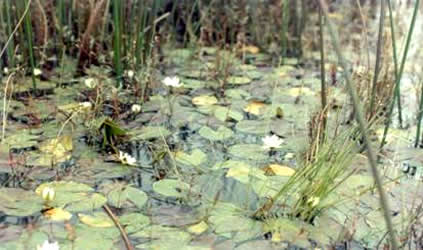Nymphaea tetragona, a rare and endangered plant of Meghalaya, India
05.01.10
by Pramod Tandon, J.C. Dang & Suman Kumaria*
The Pygmy Water-lily, Nymphaea tetragona (Ait.) Georgi (Nymphaceae), is the Asia-tropical representative of the diminutive water-lilies. It is widely distributed globally ranging from Asia-temperate, Asia-tropical, Europe and northern America. In tropical Asia, it is found in the Indian subcontinent and Indo-China where the Buddhists use the showy white to pinkish flowers, which have ornamental value in the aquaria industry, as an ‘offering flower’ and conserve it as a ‘ritual plant in temple gardens’ (Hongmao et al., 2002). The plant also has ethno-medical uses as the rhizome is used locally to cure acute diarrhea and dysentery by tribal herbal practitioners and it can also used to join bone-fractures.
India is endowed an estimated 49,000 species of plants (17,000 flowering). It, therefore, comes as little surprise that vast areas of the country have been designated as global Biodiversity Hotspots. Many of these hotspots are significant in having their endemic species concentrated in exceptionally small areas (Myers et al. 2000). In India, the original distribution of N. tetragona was confined to the states of Jammu & Kashmir and Meghalaya but came under threat due to mainly unplanned human activities, such as road construction, agricultural conversion, deforestation, animal grazing, and other factors that ruin its natural habitats. However, the species is now confined to Nongkrem Pond at Smit, Shillong in Khasi Hills, Meghalaya as an isolated population. This extant population lies on the border of the Himalayan Biodiversity Hotspot range between Bangladesh and Bhutan.
N. tetragona is a very small herb, restricted in distribution, with only a few representatives found in fragile ecosystems vulnerable to anthropogenic activities. The plants fail to regenerate in nature because of incomplete development of the embryos, plus they are also very susceptible to pests and diseases. As a result the population of this plant species is on the verge of extinction in this part of India with just 20 - 30 plants remaining in the pond.

Nymphaea tetragona blooming in its natural habitat. Just 20 - 30 plants survive in this pool but micro-propagation has not yet yielded good enough results for a re-establishment programme.
Efforts have been made by the Plant Biotechnology Group of the Botany Department at North-Eastern Hill University, Shillong to conserve and propagate the endangered lily and a protocol has been developed for propagation with premature embryos by culturing them, aseptically, in the culture room. However, the success of regeneration with tissue culture did not provide enough plants for a recovery programme despite the hardened embryo-derived plants flowering in the glasshouse after 2½ - 3 months of transfer. It remains of utmost importance to continue to protect the habitat of last remaining individuals while, simultaneously, continuing to improve propagation techniques if this rare and beautiful plant is to survive in India.
 A
A  B
B
 C
C  D
D
Plantlet regeneration of Nymphaea tetragona from premature embryos in MS medium containing the growth regulators, α-naphthalene acetic acid and 6-benzylaminopurine (A-C) and hardened plants (D)
A Multiple shoot regeneration in culture;
B Shoot regeneration with more elongated shoots;
C Plantlet regeneration with healthy leaves and roots on semi-solid medium; and
D Hardened healthy plants 6 weeks old
* Centre for Advanced Studies in Botany, North-Eastern Hill University, Shillong, India
The area is under private ownership. The Forest Department of Government of Meghalaya is entrusted with the job of conservation of this plant. Concerted efforts of Government, scientists and local people may yield desirable results and safeguard the plant's future.
References:
Hongmao, Liu, Xu Zaifu, Xu Youkai and Wang Jinxiu. 2002. Practice of conserving plant diversity through traditional beliefs: a case study in Xishuangbanna, southwest China. Biodiversity and Conservation 11: 705–713.
Myers, N., R. A. Mittermeier, C. G. Mittermeier, G. A. B. da Fonseca and J. Kent. 2000. Biodiversity hotspots for conservation priorities. Nature 403:853–858
Related links:
IN PICTURES: New species from 2009
23.12.09
 In most years - globally - approximately 2,000 new plants make themselves known to science. One of the most prolific has to be the team at Kew who collectively discovered more than 250 new species in 2009.
In most years - globally - approximately 2,000 new plants make themselves known to science. One of the most prolific has to be the team at Kew who collectively discovered more than 250 new species in 2009.
UK: Hundreds of new species round-off Kew's anniversary year
22.12.09
 It's been a remarkable year for Kew, as it celebrates its 250th year, and as we enter the International Year of Biodiversity in 2010 comes news of over 250 new species discovered by botanists from the famous London garden.
It's been a remarkable year for Kew, as it celebrates its 250th year, and as we enter the International Year of Biodiversity in 2010 comes news of over 250 new species discovered by botanists from the famous London garden.
Himalayas: Vulnerable new species at mountainous crossroads
10.08.09
 A new report by WWF - The Eastern Himalayas: Where Worlds Collide - describes more than 350 new species living at a geographical and ecological crossroad.
A new report by WWF - The Eastern Himalayas: Where Worlds Collide - describes more than 350 new species living at a geographical and ecological crossroad.